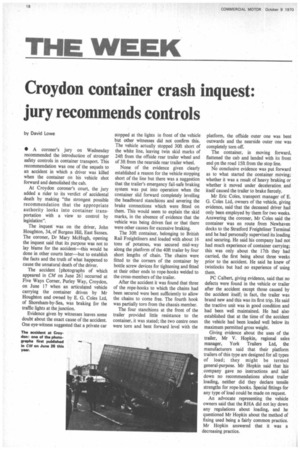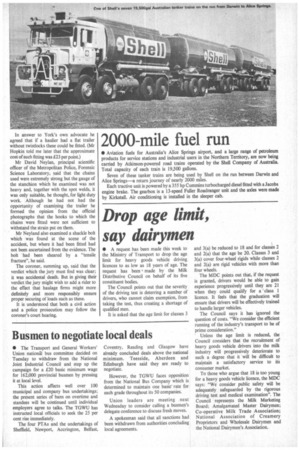Croydon container crash inquest: jury recommends controls
Page 20

Page 21

If you've noticed an error in this article please click here to report it so we can fix it.
by David Lowe • A coroner's jury on Wednesday recommended the introduction of stronger safety controls in container transport. This recommendation was one of the sequels to an accident in which a driver was killed when the container on his vehicle shot forward and demolished the cab.
At Croydon coroner's court, the jury added a rider to its verdict of accidental death by making "the strongest possible recommendation that the appropriate authority looks into container transportation with a view to control by legislation".
The inquest was on the driver, John Houghton, 34, of Burgess Hill, East Sussex. The coroner, Dr Mary McHugh, opening the inquest said that its purpose was not to lay blame for the accident—this would be done in other courts later—but to establish the facts and the truth of what happened to cause the unnatural death of the driver.
The accident [photographs of which appeared in CM on June 26] occurred at Five Ways Corner, Purley Way, Croydon, on June 17 when an articulated vehicle carrying the container driven by Mr Houghton and owned by E. G. Coles Ltd, of Shoreham-by-Sea, was braking for the traffic lights at the junction.
Evidence given by witnesses leaves some doubt about the exact cause of the accident. One eye-witness suggested that a private car
stopped at the lights in front of the vehicle but other witnesses did not confirm this. The vehicle actually stopped 30ft short of the white line, leaving twin skid marks of 24ft from the offside rear trailer wheel and of 3ft from the nearside rear trailer wheel.
None of the evidence given clearly established a reason for the vehicle stopping short of the line but there was a suggestion that the trailer's emergency fail-safe braking system was put into operation when the container slid forward completely levelling the headboard stanchions and severing the brake connections which were fitted on them. This would seem to explain the skid marks, in the absence of evidence that the vehicle was being driven fast or that there were other causes for excessive braking.
The 30ft container, belonging to British Rail Freightliners and loaded with about 16 tons of potatoes, was secured mid-way along the platform of the 40ft trailer by four short lengths of chain. The chains were fitted to the corners of the container by bottle screw devices for tightening and fitted at their other ends to rope-hooks welded to the cross-members of the trailer.
After the accident it was found that three of the rope-hooks to which the chains had been secured were bent sufficiently to allow the chains to come free. The fourth hook was partially torn from the chassis member.
The four stanchions at the front of the trailer provided little resistance to the container, it was stated; the two centre ones were torn and bent forward level with the platform, the offside outer one was bent outwards and the nearside outer one was completely torn off.
The container, in moving forward, flattened the cab and landed with its front end on the road 15ft from the stop line. No conclusive evidence was put forward as to what started the container moving; whether it was a result of heavy braking or whether it moved under deceleration and itself caused the trailer to brake fiercely.
Mr Eric Coles, transport manager of E. G. Coles Ltd, owners of the vehicle, giving evidence, said that the deceased driver had only been employed by them for two weeks. Answering the coroner, Mr Coles said the container was en route from Newhaven docks to the Stratford Freightliner Terminal and he had personally supervised its loading and securing. He said his company had not had much experience of container carrying; this was only about the 17th they had carried, the first being about three weeks prior to the accident. He said he knew of twistlocks but had no experience of using them.
PC Calbert, giving evidence, said that no defects were found in the vehicle or trailer after the accident except those caused by the accident itself; in fact, the trailer was brand new and this was its first trip. He said the tractive unit was in good condition and had been well maintained. He had also established that at the time of the accident the vehicle had been loaded well below its maximum permitted gross weight.
Giving evidence about the uses of the trailer, Mr V. Hopkin, regional sales manager, York Trailers Ltd, the manufacturers said that their platform trailers of this type are designed for all types of load; they might be termed general-purpose. Mr Hopkin said that his • company gave no instructions and laid down no recommendations about trailer loading, neither did they declare tensile strengths for rope-hooks. Special fittings for any type of load could be made on request.
An advocate representing the vehicle owners said that the RHA did not lay down any regulations about loading, and he questioned Mr Hopkin about the method of fixing used being a fairly common practice. Mr Hopkin answered that it was a decreasing practice. In answer to York's own advocate he agreed that if a haulier had a flat trailer without twistlocks these could be fitted. (Mr Hopkin told me later that the approximate cost of such fitting was £23 per point.) Mr David Neylan, principal scientific officer of the Metropolitan Police, Forensic Science Laboratory, said that the chains used were extremely strong but the gauge of the stanchion which he examined was not heavy and, together with the spot welds, it was only suitable, he thought, for light duty work. Although he had not had the opportunity of examining the trailer he formed the opinion from the official photographs that the hooks to which the chains were fitted were not sufficient to withstand the strain put on them.
Mr Neyland also examined a shackle bolt which was found at the scene of the accident, but where it had been fitted had not been ascertained from the evidence. The bolt ' had been sheared by a "tensile fracture", he said.
The coroner, summing up, said that the verdict which the jury must find was clear; it was accidental death. But in giving their verdict the jury might wish to add a rider to the effect that haulage firms might more definitely and more responsibly ensure proper securing of loads such as these.
It is understood that both a civil action and a police prosecution may follow the coroner's court hearing.








































































































